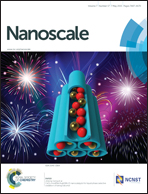CeO2-modified Au@SBA-15 nanocatalysts for liquid-phase selective oxidation of benzyl alcohol†
Abstract
Tuning the interfacial perimeter and structure is crucial to understanding the origin of catalytic performance. This paper describes the design, characterization, and application of CeO2 modified Au@SBA-15 (Au–CeO2@SBA-15) catalysts in selective oxidation of benzyl alcohol. The reaction results showed that Au–CeO2@SBA-15 catalysts exhibited higher catalytic activity compared with Au@SBA-15 and Au/CeO2 catalysts under identical conditions along with the high selectivity towards benzaldehyde (>99%). The turnover frequency of benzyl alcohol over the Au–100CeO2@SBA-15 catalyst is about nine-fold and four-fold higher than those of Au@SBA-15 and Au/CeO2 catalysts, respectively. The supported catalysts were characterized by N2 adsorption–desorption, inductively coupled plasma optical emission spectroscopy, X-ray diffraction, transmission electron microscopy, high-angle annular dark-field scanning transmission electron microscopy, scanning transmission electron microscopy-energy dispersive spectrometry, and X-ray photoelectron spectroscopy. It was found that the Au and small CeO2 nanoparticles (∼5 nm) were homogeneously mixed in the channels of SBA-15, which led to an increase in the interfacial area between Au and CeO2 and consequently a better catalytic performance of Au–CeO2@SBA-15 catalysts for the selective oxidation of benzyl alcohol to benzaldehyde compared with that of Au/CeO2. The prevention of agglomeration and leaching of Au nanoparticles by restricting them inside the mesopores of SBA-15 was conducive to the stable existence of large quantities of Au–CeO2 interface, which leads to high stability of the Au–CeO2@SBA-15 catalyst.


 Please wait while we load your content...
Please wait while we load your content...